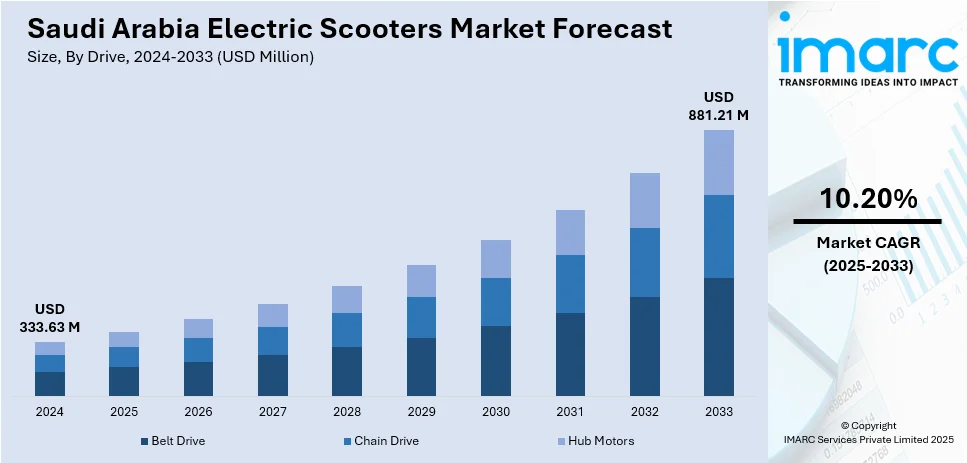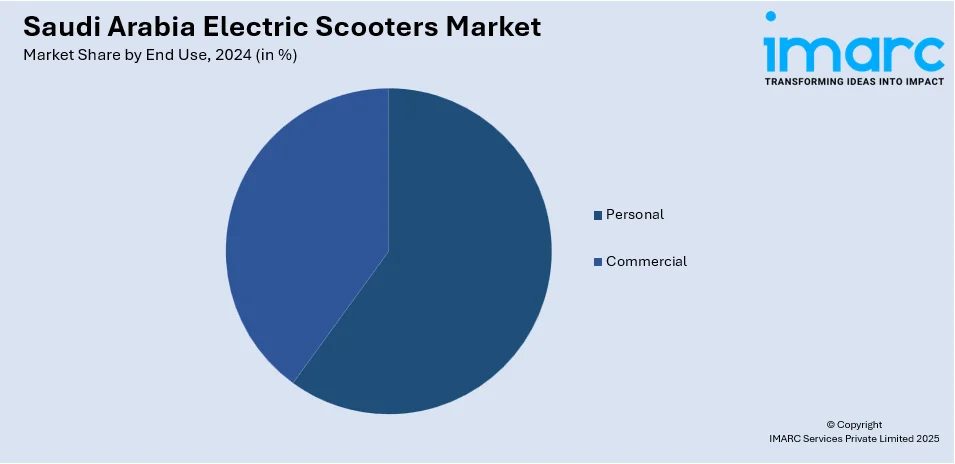
Saudi Arabia Electric Scooters Market Size, Share, Trends and Forecast by Drive, Battery, Product, Battery Fitting, End Use, and Region, 2025-2033
Saudi Arabia Electric Scooters Market Overview:
The Saudi Arabia electric scooters market size reached USD 333.63 Million in 2024. Looking forward, IMARC Group expects the market to reach USD 881.21 Million by 2033, exhibiting a growth rate (CAGR) of 10.20% during 2025-2033. The market is gaining momentum due to the growing interest in eco-friendly transport and smart city development, and increased consumer awareness about environment. Rising fuel costs and traffic congestion are also encouraging a shift toward compact, energy-efficient mobility solutions. Local initiatives promoting green mobility and innovation in design and performance is further enhancing user appeal, contributing to the expanding Saudi Arabia electric scooters market share.
|
Report Attribute
|
Key Statistics
|
|---|---|
|
Base Year
|
2024
|
|
Forecast Years
|
2025-2033
|
|
Historical Years
|
2019-2024
|
| Market Size in 2024 | USD 333.63 Million |
| Market Forecast in 2033 | USD 881.21 Million |
| Market Growth Rate 2025-2033 | 10.20% |
Saudi Arabia Electric Scooters Market Trends:
Growing Investment in Charging Infrastructure
The growth of the electric scooter market in Saudi Arabia is being supported by significant investments in charging infrastructure, particularly in key urban areas such as Riyadh, Jeddah, and Dhahran. As electric scooters become a more popular mode of transport, the need for convenient and accessible charging stations is critical. For instance, in October 2023, Saudi Arabia's Public Investment Fund and the Saudi Electricity Company launched the Electric Vehicle Infrastructure Company to establish over 5,000 fast chargers by 2030. The initiative aims to enhance the EV ecosystem, promote private sector involvement, and support local R&D, aligning with the Kingdom's Vision 2030 economic diversification goals. These investments are being led by both the public and private sector to further promote the uptake of sustainable transport means. Charging points are being strategically located along busy areas, such as malls, transport stations, and public areas, to facilitate easy charging of scooters for users while on the move. This is addressing some of the issues related to range anxiety, thus electric scooters being more convenient and dependable for everyday use. With the growth of the charging network, it is anticipated to immensely increase the use of electric scooters throughout the Kingdom.

Rapid Urbanization and Mobility Solutions
Rapid urbanization and increasing traffic congestion in cities like Riyadh and Jeddah are fueling the Saudi Arabia electric scooters market growth. According to the industry reports, as of May 2025, Saudi Arabia's population is 34,503,672, projected to reach 34,566,328 mid-year. With a population density of 16 people per km² and 92.12% urbanization, approximately 31,842,626 residents live in urban areas. As more people flock to urban centers for work and leisure, traditional transportation options have become less efficient, contributing to longer commute times and increased air pollution. In response, electric scooters are emerging as a convenient, eco-friendly solution for short-distance travel. Their ability to navigate congested streets quickly and their low environmental impact make them an attractive alternative. With their affordability and ease of use, electric scooters are gaining popularity as a smart, sustainable mode of urban transport. As cities in Saudi Arabia continue to expand, the demand for such mobility solutions is expected to rise, propelling the growth of the electric scooter market and aligning with the country’s broader sustainability goals.
Saudi Arabia Electric Scooters Market Segmentation:
IMARC Group provides an analysis of the key trends in each segment of the market, along with forecasts at the country and regional levels for 2025-2033. Our report has categorized the market based on drive, battery, product, battery fitting, and end use.
Drive Insights:
- Belt Drive
- Chain Drive
- Hub Motors
The report has provided a detailed breakup and analysis of the market based on the drive. This includes belt drive, chain drive, and hub motors.
Battery Insights:
- Lead Acid
- Lithium Ion
- Others
A detailed breakup and analysis of the market based on the battery have also been provided in the report. This includes lead acid, lithium ion, and others.
Product Insights:
- Standard
- Folding
- Self-Balancing
- Maxi
- Three Wheeled
A detailed breakup and analysis of the market based on the product have also been provided in the report. This includes standard, folding, self-balancing, maxi, and three wheeled.
Battery Fitting Insights:
- Detachable
- Fixed
A detailed breakup and analysis of the market based on the battery fitting have also been provided in the report. This includes detachable and fixed.
End Use Insights:

- Personal
- Commercial
A detailed breakup and analysis of the market based on the end use have also been provided in the report. This includes personal and commercial.
Regional Insights:
- Northern and Central Region
- Western Region
- Eastern Region
- Southern Region
The report has also provided a comprehensive analysis of all the major regional markets, which include Northern and Central Region, Western Region, Eastern Region, and Southern Region.
Competitive Landscape:
The market research report has also provided a comprehensive analysis of the competitive landscape. Competitive analysis such as market structure, key player positioning, top winning strategies, competitive dashboard, and company evaluation quadrant has been covered in the report. Also, detailed profiles of all major companies have been provided.
Saudi Arabia Electric Scooters Market News:
- In February 2025, NAVEE launched its new electric scooters in Saudi Arabia, including the ST3 Pro, GT3 Pro, and V25i Pro. This initiative supports Saudi Arabia's Vision 2030 for sustainable transport. The scooters feature advanced technology, impressive range, and enhanced safety, with promotional offers.
Saudi Arabia Electric Scooters Market Report Coverage:
| Report Features | Details |
|---|---|
| Base Year of the Analysis | 2024 |
| Historical Period | 2019-2024 |
| Forecast Period | 2025-2033 |
| Units | Million USD |
| Scope of the Report |
Exploration of Historical Trends and Market Outlook, Industry Catalysts and Challenges, Segment-Wise Historical and Future Market Assessment:
|
| Drives Covered | Belt Drive, Chain Drive, Hub Motors |
| Batteries Covered | Lead Acid, Lithium Ion, Others |
| Products Covered | Standard, Folding, Self-Balancing, Maxi, Three Wheeled |
| Battery Fittings Covered | Detachable, Fixed |
| End Uses Covered | Personal, Commercial |
| Regions Covered | Northern and Central Region, Western Region, Eastern Region, Southern Region |
| Customization Scope | 10% Free Customization |
| Post-Sale Analyst Support | 10-12 Weeks |
| Delivery Format | PDF and Excel through Email (We can also provide the editable version of the report in PPT/Word format on special request) |
Key Questions Answered in This Report:
- How has the Saudi Arabia electric scooters market performed so far and how will it perform in the coming years?
- What is the breakup of the Saudi Arabia electric scooters market on the basis of drive?
- What is the breakup of the Saudi Arabia electric scooters market on the basis of battery?
- What is the breakup of the Saudi Arabia electric scooters market on the basis of product?
- What is the breakup of the Saudi Arabia electric scooters market on the basis of battery fitting?
- What is the breakup of the Saudi Arabia electric scooters market on the basis of end use?
- What is the breakup of the Saudi Arabia electric scooters market on the basis of region?
- What are the various stages in the value chain of the Saudi Arabia electric scooters market?
- What are the key driving factors and challenges in the Saudi Arabia electric scooters market?
- What is the structure of the Saudi Arabia electric scooters market and who are the key players?
- What is the degree of competition in the Saudi Arabia electric scooters market?
Key Benefits for Stakeholders:
- IMARC’s industry report offers a comprehensive quantitative analysis of various market segments, historical and current market trends, market forecasts, and dynamics of the Saudi Arabia electric scooters market from 2019-2033.
- The research report provides the latest information on the market drivers, challenges, and opportunities in the Saudi Arabia electric scooters market.
- Porter's five forces analysis assist stakeholders in assessing the impact of new entrants, competitive rivalry, supplier power, buyer power, and the threat of substitution. It helps stakeholders to analyze the level of competition within the Saudi Arabia electric scooters industry and its attractiveness.
- Competitive landscape allows stakeholders to understand their competitive environment and provides an insight into the current positions of key players in the market.
Need more help?
- Speak to our experienced analysts for insights on the current market scenarios.
- Include additional segments and countries to customize the report as per your requirement.
- Gain an unparalleled competitive advantage in your domain by understanding how to utilize the report and positively impacting your operations and revenue.
- For further assistance, please connect with our analysts.
 Request Customization
Request Customization
 Speak to an Analyst
Speak to an Analyst
 Request Brochure
Request Brochure
 Inquire Before Buying
Inquire Before Buying




.webp)




.webp)












